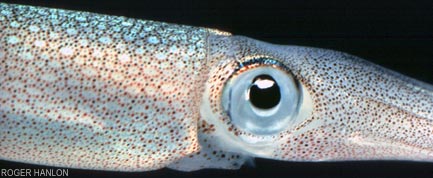
Squid have excellent eyesight, a keen sense of smell, and the ability to squirt jets of dark ink that mask their escape. But these skills provide little protection against toothed whales, like the sperm whale, which hunt them ruthlessly and easily.
“The numbers of squid that are eaten by sperm whales far exceed those harvested by men for food on a worldwide basis,” said squid-expert Roger Hanlon of the Marine Biological Laboratory in Woods Hole, Massachusetts.
How the whales manage to subdue such able prey has been a mystery. One hypothesis, proposed more than 20 years ago, speculated the whales used powerful ultrasound shrieks to knock their squid prey senseless before scooping them up. Like bats and dolphins, some whales use ultrasonic clicks to find prey and navigate. [See Photos of Vampire Squid from Hell]
While controversial among scientists, the idea has become a part of whale lore, adding to the mystery that surrounds the clandestine struggles between leviathan and squids that occur within the ocean depths every day.
But a new study by Hanlon and his colleagues deflates this myth, demonstrating not only that squid cannot be paralyzed by whale ultrasound, they are not even aware they are being targeted.
The team's findings are detailed in the July 7 issue of the journal Biology Letters.
Oblivious
Get the world’s most fascinating discoveries delivered straight to your inbox.
The researchers played recorded ultrasound whale clicks to several long-finned squid (Loligo pealeii) swimming in a water tank. This species of squid grows to about a foot long and is commonly found off the coast of the northeastern United States. [Photos of the Stunning Deep-Sea Squid Feeding]
The ultrasound clicks were broadcast at up to 226 decibels, which is about the most intense whale echolocation click a squid would be exposed to in the wild. If the clicks were at a frequency humans could hear, they would be as loud as a rifle shot heard from three feet in front of the muzzle.
“That would shatter our eardrums. It’s a deafening sound to an animal that can perceive it,” Hanlon told LiveScience.
But not only were the squid not knocked senseless, they did not react at all to the ultrasound bursts, and actually swam in front of the speaker as if nothing were happening.
“That’s like a Bose commercial where you’re sitting there and your hair is straight back because the sound is blasting out,” Hanlon said. “That to us was a stunning result. We did the experiment several times over because we could hardly believe it ourselves.”
So if whales don’t use sound waves to knock out squid, how do they catch them? “Why can’t [squids] see some aspects of this big whale heading down on them at a zillion miles an hour? That’s a big mystery,” Hanlon said.
Do the twist
One clue comes from observations of whale hunting in the wild made by study team members Peter Tyack and Peter Madsen, of the Woods Hole Oceanographic Institution and the University of Aarhus in Denmark, respectively.
The researchers recorded whales twisting their bodies just before snatching a squid in their jaws. “They often catch the prey in a rapid turn during which the whales turn upside down to position themselves with respect to the prey,” Tyack said.
This twisting maneuver appears to somehow allow the whales to create a powerful suction with their mouths which they use to vacuum in squid from up to three feet away.
Some squid are large enough to fight back: Sperm whales have been found with suction scars on their skin. But most squid species make easy pickings for the whales that hunt them.
While toothed whales don’t seem to use sound to zap squid, some whale species are known to use sound to hunt fish. Humpback whales, for example, broadcast sound waves that drive herring fish into tight schools at the surface of the water for easier capture.
Other humpbacks simultaneously blow a “net” of bubbles that encircles the rising school. The whales then swim up the trap from beneath to scoop the clusters of frightened fish into their open mouths.
Follow us @livescience, Facebook & Google+.


